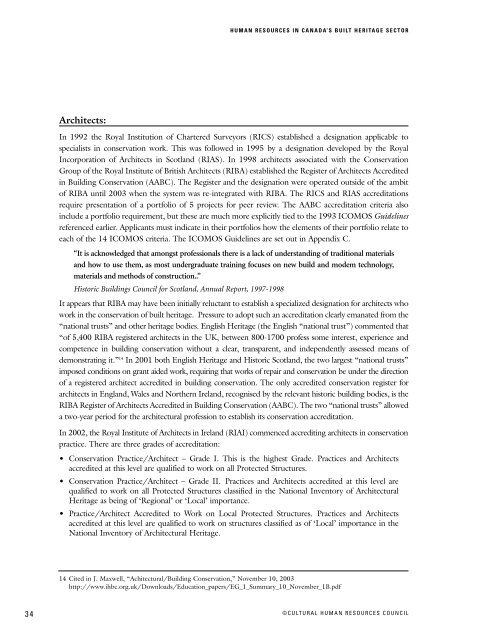Human Resources in Canada's Built Heritage Sector: Mapping the ...
Human Resources in Canada's Built Heritage Sector: Mapping the ...
Human Resources in Canada's Built Heritage Sector: Mapping the ...
- No tags were found...
Create successful ePaper yourself
Turn your PDF publications into a flip-book with our unique Google optimized e-Paper software.
HUMAN RESOURCES IN CANADA’S BUILT HERITAGE SECTORArchitects:In 1992 <strong>the</strong> Royal Institution of Chartered Surveyors (RICS) established a designation applicable tospecialists <strong>in</strong> conservation work. This was followed <strong>in</strong> 1995 by a designation developed by <strong>the</strong> RoyalIncorporation of Architects <strong>in</strong> Scotland (RIAS). In 1998 architects associated with <strong>the</strong> ConservationGroup of <strong>the</strong> Royal Institute of British Architects (RIBA) established <strong>the</strong> Register of Architects Accredited<strong>in</strong> Build<strong>in</strong>g Conservation (AABC). The Register and <strong>the</strong> designation were operated outside of <strong>the</strong> ambitof RIBA until 2003 when <strong>the</strong> system was re-<strong>in</strong>tegrated with RIBA. The RICS and RIAS accreditationsrequire presentation of a portfolio of 5 projects for peer review. The AABC accreditation criteria also<strong>in</strong>clude a portfolio requirement, but <strong>the</strong>se are much more explicitly tied to <strong>the</strong> 1993 ICOMOS Guidel<strong>in</strong>esreferenced earlier. Applicants must <strong>in</strong>dicate <strong>in</strong> <strong>the</strong>ir portfolios how <strong>the</strong> elements of <strong>the</strong>ir portfolio relate toeach of <strong>the</strong> 14 ICOMOS criteria. The ICOMOS Guidel<strong>in</strong>es are set out <strong>in</strong> Appendix C.“It is acknowledged that amongst professionals <strong>the</strong>re is a lack of understand<strong>in</strong>g of traditional materialsand how to use <strong>the</strong>m, as most undergraduate tra<strong>in</strong><strong>in</strong>g focuses on new build and modem technology,materials and methods of construction..”Historic Build<strong>in</strong>gs Council for Scotland, Annual Report, 1997-1998It appears that RIBA may have been <strong>in</strong>itially reluctant to establish a specialized designation for architects whowork <strong>in</strong> <strong>the</strong> conservation of built heritage. Pressure to adopt such an accreditation clearly emanated from <strong>the</strong>“national trusts” and o<strong>the</strong>r heritage bodies. English <strong>Heritage</strong> (<strong>the</strong> English “national trust”) commented that“of 5,400 RIBA registered architects <strong>in</strong> <strong>the</strong> UK, between 800-1700 profess some <strong>in</strong>terest, experience andcompetence <strong>in</strong> build<strong>in</strong>g conservation without a clear, transparent, and <strong>in</strong>dependently assessed means ofdemonstrat<strong>in</strong>g it.” 14 In 2001 both English <strong>Heritage</strong> and Historic Scotland, <strong>the</strong> two largest “national trusts”imposed conditions on grant aided work, requir<strong>in</strong>g that works of repair and conservation be under <strong>the</strong> directionof a registered architect accredited <strong>in</strong> build<strong>in</strong>g conservation. The only accredited conservation register forarchitects <strong>in</strong> England, Wales and Nor<strong>the</strong>rn Ireland, recognised by <strong>the</strong> relevant historic build<strong>in</strong>g bodies, is <strong>the</strong>RIBA Register of Architects Accredited <strong>in</strong> Build<strong>in</strong>g Conservation (AABC). The two “national trusts” alloweda two-year period for <strong>the</strong> architectural profession to establish its conservation accreditation.In 2002, <strong>the</strong> Royal Institute of Architects <strong>in</strong> Ireland (RIAI) commenced accredit<strong>in</strong>g architects <strong>in</strong> conservationpractice. There are three grades of accreditation:• Conservation Practice/Architect – Grade I. This is <strong>the</strong> highest Grade. Practices and Architectsaccredited at this level are qualified to work on all Protected Structures.• Conservation Practice/Architect – Grade II. Practices and Architects accredited at this level arequalified to work on all Protected Structures classified <strong>in</strong> <strong>the</strong> National Inventory of Architectural<strong>Heritage</strong> as be<strong>in</strong>g of ‘Regional’ or ‘Local’ importance.• Practice/Architect Accredited to Work on Local Protected Structures. Practices and Architectsaccredited at this level are qualified to work on structures classified as of ‘Local’ importance <strong>in</strong> <strong>the</strong>National Inventory of Architectural <strong>Heritage</strong>.14 Cited <strong>in</strong> J. Maxwell, “Achitectural/Build<strong>in</strong>g Conservation,” November 10, 2003http://www.ihbc.org.uk/Downloads/Education_papers/EG_1_Summary_10_November_1B.pdf34©CULTURAL HUMAN RESOURCES COUNCIL










